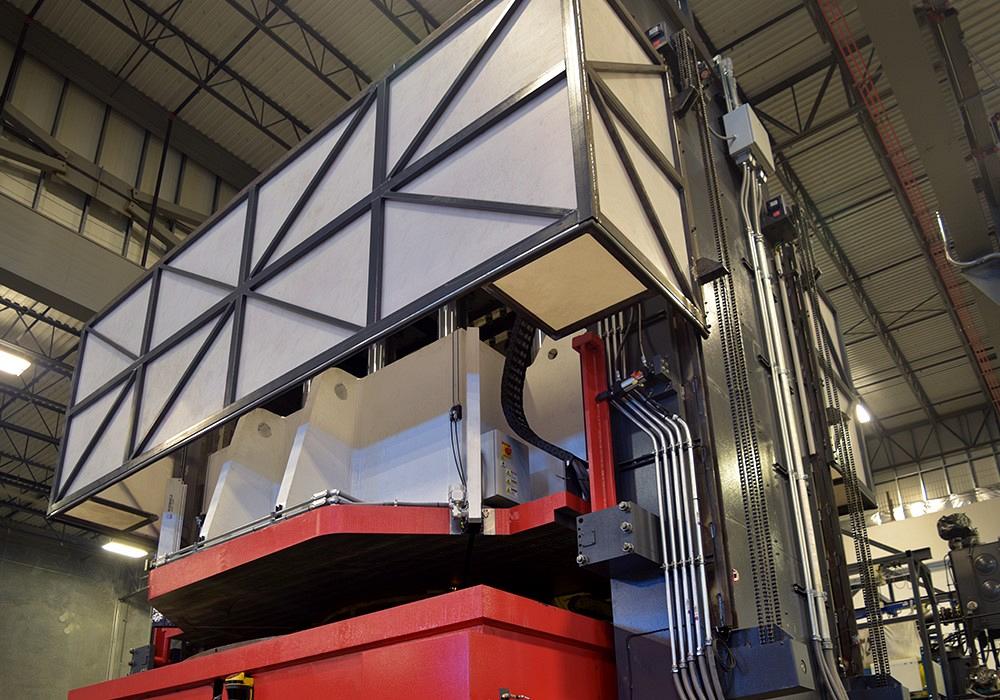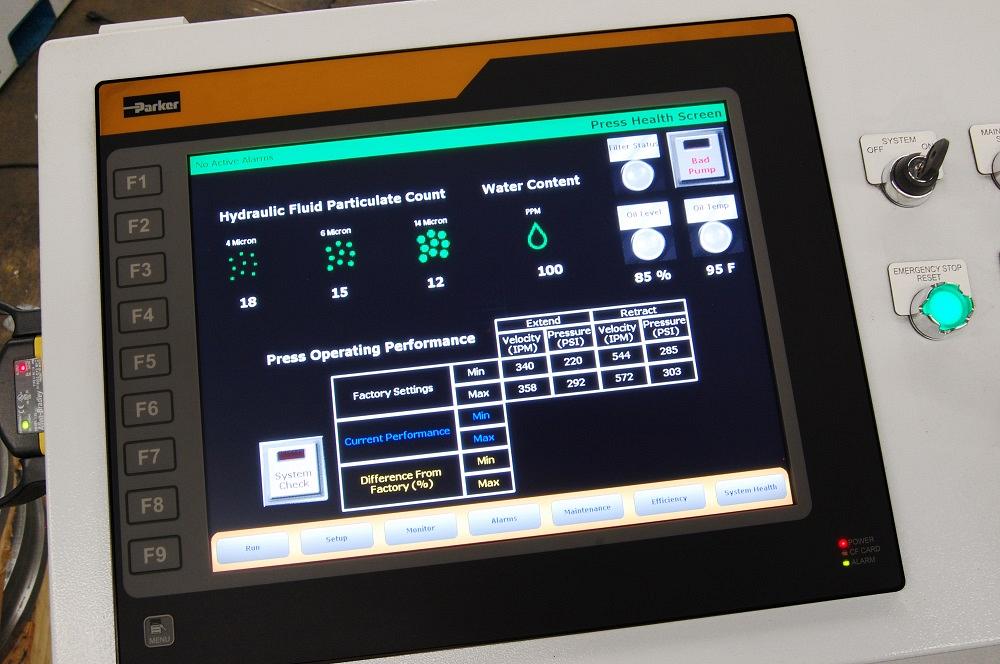Sales Manager
- FMA
- The Fabricator
- FABTECH
- Canadian Metalworking
Categories
- Additive Manufacturing
- Aluminum Welding
- Arc Welding
- Assembly and Joining
- Automation and Robotics
- Bending and Forming
- Consumables
- Cutting and Weld Prep
- Electric Vehicles
- En Español
- Finishing
- Hydroforming
- Laser Cutting
- Laser Welding
- Machining
- Manufacturing Software
- Materials Handling
- Metals/Materials
- Oxyfuel Cutting
- Plasma Cutting
- Power Tools
- Punching and Other Holemaking
- Roll Forming
- Safety
- Sawing
- Shearing
- Shop Management
- Testing and Measuring
- Tube and Pipe Fabrication
- Tube and Pipe Production
- Waterjet Cutting
Industry Directory
Webcasts
Podcasts
FAB 40
Advertise
Subscribe
Account Login
Search
Hydraulic press technology trends that boost energy efficiency, usability
Technological developments that are adaptable and flexible in a stamping environment
- By Caleb Dixon
- April 8, 2022
- Article
- Bending and Forming

Hydraulic press technology has advanced over the years, but its ability to form very large components needing high tonnage and complete flexibility because it can apply maximum tonnage anywhere in the stroke remains a chief benefit. Shown is a 3,500-ton hydraulic press used to bulge-form a tank head.
Hydraulic press technology has advanced consistently over the years, but in small steps rather than huge leaps. The technology has focused on improving energy efficiency, uptime, automation, and usability. These technological developments make hydraulic presses adaptable and flexible in a stamping environment.
Energy Efficiency
As the market shifts to an emphasis on clean energy, a rising number of stamping manufacturers now focus on using energy-efficient equipment. Technologies like variable-frequency drives, which draw energy on demand during the forming process, generate energy cost savings while reducing noise output. Pneumatic dwell circuits commonly are used to reduce energy consumption during long dwell cycles by monitoring and adjusting pressure via a pneumatic pump.
The more it costs to operate your equipment, the more it directly affects your return on investment. Stampers are moving into the energy-efficient realm not only for financial reasons, but for a cleaner environment as well.
Uptime via Machine Monitoring
In the press industry, increasing uptime is key for on-time production. Stampers are searching for presses equipped with features that focus on proactive monitoring of critical press components and systems, including oil health, lubricant, pumps, and motors, to minimize unplanned downtime. Having advanced warning systems allows stampers to plan for maintenance during nonpeak hours.
Material Handling Automation
As the labor market tightens, more stamping manufacturers are shifting to automated equipment. Over the last 10 years, automation has become more cost-effective, driving the industry toward completely automated workcells.
Automation can be as simple as a shuttle system or as complex as a fully automated cellular environment with robotic machine tending, scrap removal systems, and quick die change systems.
In a fully automated workcell, stampers can form the part completely in one cell rather than assembling it on one machine, then sending it across the facility for secondary finishing. A fully automated cell allows stampers to start with a blank and end with a complete part in one area of the facility.
Automation not only decreases the need for labor, but it improves speed, throughput, part quality, and operator safety.
Simpler Controls for Usability
One of the biggest advancements in hydraulic press technology is the modern and improved controls. Previously stamping manufacturers had to rely on skilled operators to make consistent parts. Now upgraded controls have turned the operation of a hydraulic press from an art into a science. Modern controls are programmed to be user-friendly for the operator, while optimizing part quality and repeatable forming.
With these new control systems, operations are simplified using recipe parameters that can be fully customized to every forming process. Once a recipe is created, operators have the option to enter their part number in the HMI or scan bar codes or radio frequency identification tags (RFID) on their tooling. RFID tags use radio frequencies to search, identify, track, and communicate information about the part to the operator. With these technologies, operators simply load the blank into the press and hit the cycle start button; the equipment does the rest.

Proactive monitoring of critical press components and systems including oil health, lubricant, pumps, and motors helps stampers plan for maintenance during nonpeak hours.
Standardized Hydraulic Presses
While having a press customized to a stamper’s exact needs improves overall process efficiency, recent market conditions have prompted many OEMs to develop standardized hydraulic press lines. Stampers often cannot wait six months or more for a custom press because of internal goals and pressures. Buying a pre-engineered design increases production time and reduces upfront cost—two important factors in today’s just-in-time manufacturing landscape. On these standard lines, OEMs can preconfigure presses with varying tonnages and forming areas to work for multiple applications and industries. While some processes will always require customization, many others can be performed on standard machinery.
Expanding Industries: Electric Vehicles and Space
With new hydraulic trends comes an expansion into new industries and applications. The space and electric vehicle industries are quickly growing, accompanied by an increased need for high-precision machinery and equipment.
In the space industry, companies are using vertical integration because of the component sizes. Finding suppliers with the capacity to make large components for rockets is rare, so space companies are sourcing large forming equipment to make their parts in-house. Production volume in the space industry is small, with about 30 parts a year being formed in many cases.
In the electric vehicle industry, companies are researching and designing new propulsion systems and batteries to accommodate fully electric cars with long-range capabilities. This includes solid-state battery suppliers that need flexible equipment to advance their R&D efforts into production.
Servo Electric as Alternative?
For some hydraulic press applications requiring less than 200 tons, a newly developed servo-electric press may be a good alternative.
The main reason manufacturers switch to electric presses is precision and accuracy. Over the last decade, hydraulic presses have advanced in precision but still can’t compete with the precision offered by servo-electric presses. A servo-electric press holds a positional tolerance of +/- 0.0005 in. and a force tolerance of +/-0.5%. A hydraulic press can get close to those positional and force tolerances using add-ons such as proportional valves and delta motion controllers, but still can’t get the precise tolerances of a servo-electric.
Another advantage of servo-electric presses is the reduced maintenance. These presses use an electric actuator to create pressure, so the hydraulic power unit (HPU) is eliminated. Stampers don’t have to worry about the pump failures, oil leaks, or hose malfunctions on a hydraulic press or the costly crankshaft and flywheel repairs on a mechanical press. Servo-electric presses can last for millions of cycles before maintenance is required. Without the HPU, electric presses are also quieter, cleaner, and more energy-efficient.
Stampers looking to upgrade from hydraulic to servo-electric actuation also have the option to retrofit existing machinery, saving cost and lead time compared to a new press.
The limitation of servo-electric press technology is in the tonnage capacity. Generally, the force is capped at 200 tons because of the cost of the actuators. Any application needing more than 200 tons is better-suited for a hydraulic press at this time. Or if ancillary operations require multiple cylinders, a hydraulic press is more cost-efficient because one HPU is capable of powering all of the cylinders.
Some Things Never Change
The main advantage of a hydraulic press still is its flexibility. Stampers have ultimate control over press tonnage, speed, cycle parameters, and more. For example, if a stamper needs to achieve maximum tonnage throughout the entire stroke to control material flow during a deep-draw cycle, it could not use a mechanical press, which reaches full tonnage only at the bottom of the stroke. Hydraulic presses are suitable for applications like deep drawing that require flexibility and adaptability.
With all the modernized technological advances available on hydraulic presses today (e.g., user-friendly controls, recipe handling, automation, and press monitoring systems), their forming flexibility is hard to beat.
About the Author
Caleb Dixon
2086 Fenton Logistics Park
St. Louis, MO 63026
Related Companies
subscribe now

The Fabricator is North America's leading magazine for the metal forming and fabricating industry. The magazine delivers the news, technical articles, and case histories that enable fabricators to do their jobs more efficiently. The Fabricator has served the industry since 1970.
start your free subscription- Stay connected from anywhere

Easily access valuable industry resources now with full access to the digital edition of The Fabricator.

Easily access valuable industry resources now with full access to the digital edition of The Welder.

Easily access valuable industry resources now with full access to the digital edition of The Tube and Pipe Journal.
- Podcasting
- Podcast:
- The Fabricator Podcast
- Published:
- 04/16/2024
- Running Time:
- 63:29
In this episode of The Fabricator Podcast, Caleb Chamberlain, co-founder and CEO of OSH Cut, discusses his company’s...
- Trending Articles
How to set a press brake backgauge manually

Capturing, recording equipment inspection data for FMEA

Tips for creating sheet metal tubes with perforations

Are two heads better than one in fiber laser cutting?

Hypertherm Associates implements Rapyuta Robotics AMRs in warehouse

- Industry Events
16th Annual Safety Conference
- April 30 - May 1, 2024
- Elgin,
Pipe and Tube Conference
- May 21 - 22, 2024
- Omaha, NE
World-Class Roll Forming Workshop
- June 5 - 6, 2024
- Louisville, KY
Advanced Laser Application Workshop
- June 25 - 27, 2024
- Novi, MI



























